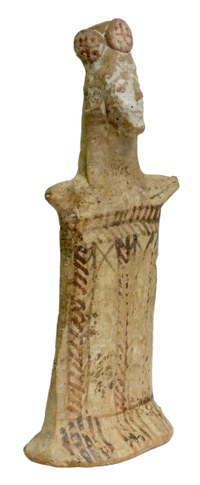Boeotian pappas
|
Böotisches Brettidol Inv. T I-2 Solid. Front of the head from the mould, body formed by hand, back cursorily smoothed. Polos, decorative discs and hair strands attached. Fine lean ochre (10 YR 7/4) clay with minor sandy inclusions. White engobe on face and polos. Rich, partly incompletely preserved painting with light brown and black-brown colour on the robe and arm stumps. Also reddish brown on the robe, red on the ornamental discs. Pupils black. Provenance: Unknown. State of preservation: Left strand of hair lost, small missing part at the temple on the right. Sloping fracture line in the lower third of the neck, smudged; otherwise intact. Dimensions: H: 19,1 cm; W: 8,6 cm; D: 3,0 cm. References: M. Recke, Antike Kunst aus der Sammlung der Justus-Liebig-Universität (Gießen 2010) 22. 27, Nno 44; W. Zschietzschmann, Gießener Antiken, in: Hessische Heimat 15/18. 7. 1962, 58 fig. 3. |
Description: The figure stands on the flared lower section of the robe. The body is slightly concave. The short arm stumps end pointedly. On the broad, long neck sits a high head crowned by a moderately high polos decorated with ornamental discs.
Fine hair arches frame the forehead and temples. Long strands fall to the shoulders in the form of broad, sculpturally applied bands. The chin protrudes sharply from the oval face. The large eyes, set wide apart, are framed by narrow, sculpted lids. Small black dots mark the pupils. The nose is strong, the mouth broad, with full lips and raised corners of the mouth.
The robe shows bands with a herringbone pattern, crossed lines in between and vertical groups of strokes on the hem. Dots and dashes on the arm stumps. Fine vertical wavy lines suggest a necklace.
Crosses on the decorative discs, dots in the segments. Horizontal lines on the lateral hair strands recall the stepped hairstyles of the Daedalian period. On the back a group of vertical wavy lines over the middle of the body, on the sides groups of diagonal lines.
Commentary: The statuette shows some characteristics of Boeotian "bird-headed idols": it stands without support and has a flat concave contour in the side view. Also: plastically applied strands of hair[1], decorative discs on the lower polos[2], tapering short arm stumps[3]. The head, however, is not bird-like but anthropomorphic and is not formed by hand but from the matrix[4].
Compared to the 'Corinthianising' statuettes with their radiant colours, the narrow rectangular body and high polos[5], the Giessen example appears stocky and somewhat inconspicuous.
The figure was probably created around the middle of the 6th century BC, before Boeotian coroplastics turned entirely to matt-painting[6]. Parallels from datable grave contexts in Rhitsona[7] confirm the chronological approach.
Determination: c. 550 BC, Boeotia.
 |
 |
 |
|---|
[1] R. A. Higgins, Greek Terracottas (London 1967) 45 f. pls. 18 b. d.
[2] Marangou 1985, 127 no. 184; S. Mollard-Besques 1954, B 61; B 76. The motif of the decorative disc could indicate Argivian influence, Szabó 1994, 69. 96-101.
[3] Higgins 1967, 45 f. pl. 18 a. c; Zahlhaas 1985, 87 f. no. 34 pl. 22.
[4] P. Blome (Hrsg.), Orient und frühes Griechenland (Basel 1990) 95 no. 142.
[5] Grace 1969, 31 figs. 20. 21.
[6] Szabó 1994, 69.
[7] Ure 1934, 55 no. 49.426 pl. 13.

